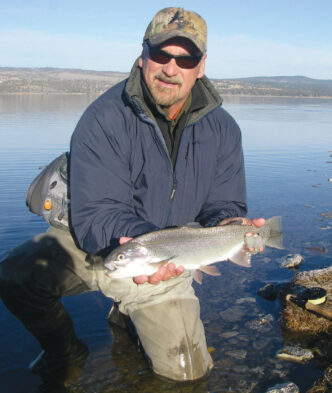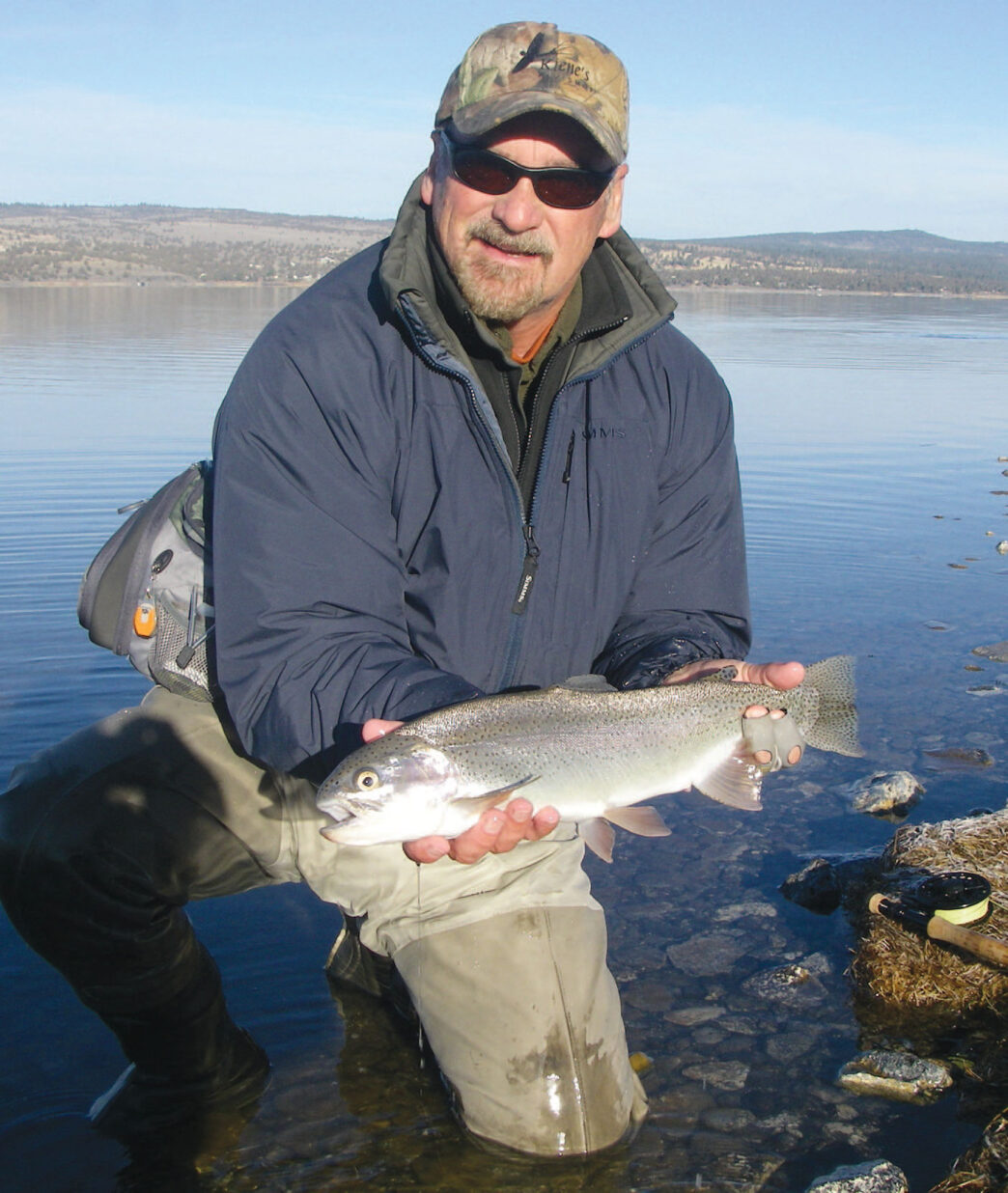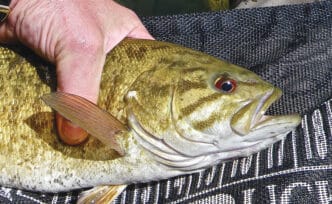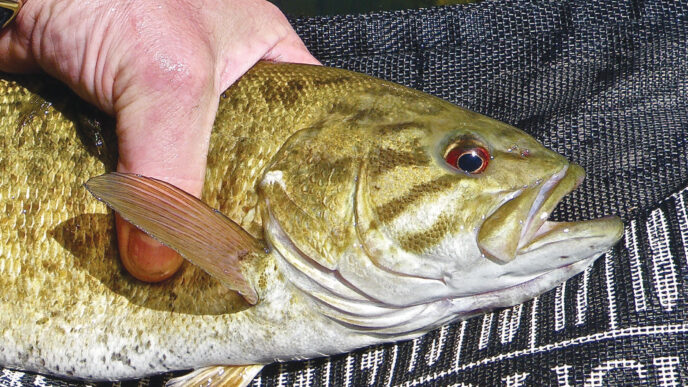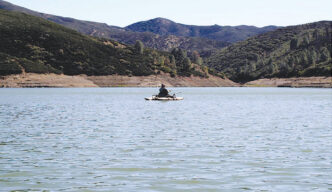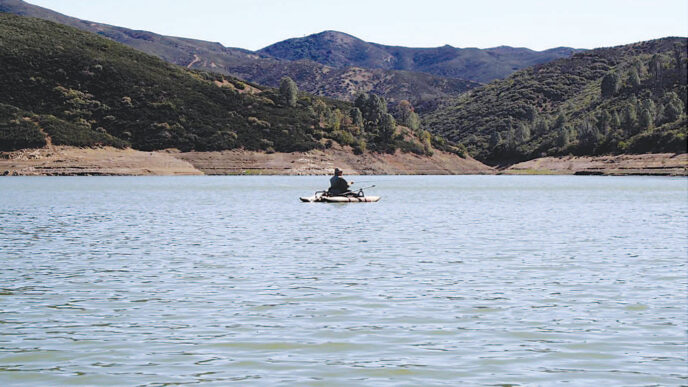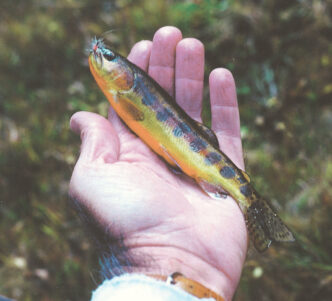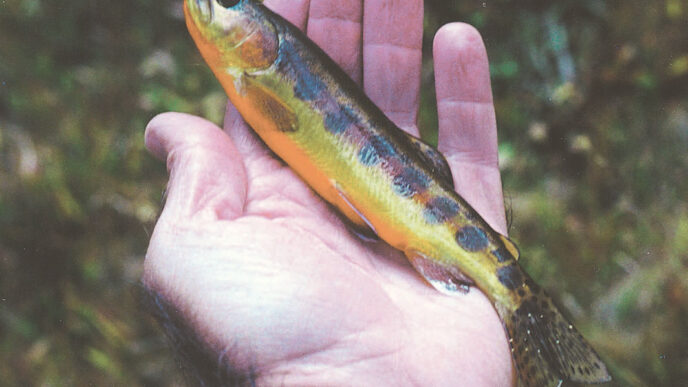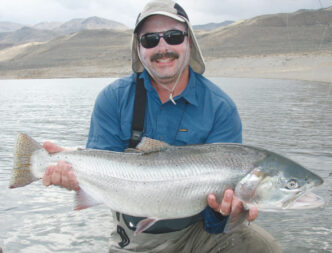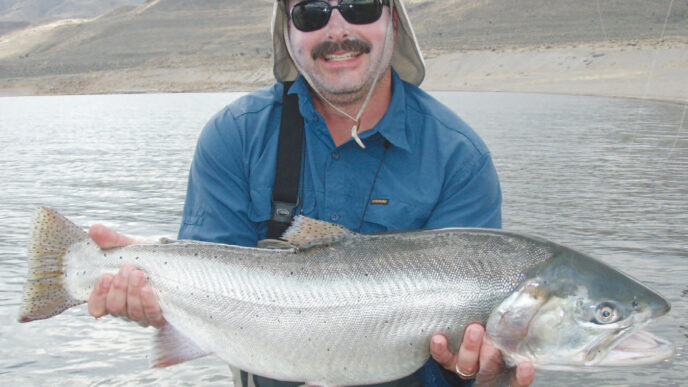The person who said that the worst day fishing beats the best day working never fished Eagle Lake in November. The weather on the November morning I arrived at Eagle Lake was terrible, with snow, wind, rain, and cold. The wind was blowing 20 miles per hour and with the wind chill, the temperature was hovering in the 20s. The snow was flying around in the wind with such force that when it hit your skin, it felt like little glass shards were piercing it. Of course, that is perfect fishing weather on Eagle Lake. Jay Fair, the lake’s legendary flyfishing guide, always has detested bluebird weather. He will become grumpy, shake his head, and curse the clear skies.
This article is not about Jay Fair, but an article on Eagle Lake that did not include a few words about Jay Fair and the weather would be incomplete, and it was in terrible weather on what turned out to be one of the best days’ fishing I have ever had on Eagle Lake that I met Jay Fair. I was getting my boat ready to launch at the Spaulding boat ramp, but Jay had backed his boat and trailer down into the water ahead of me and was just sitting in his truck sipping on a cup of hot coffee. When I finally went to ask what was causing the delay, he just looked at me and said, “Good morning.” At that instant, a huge boom rattled the truck, and he smiled and said, “Stand back son. My trailer is free.” The boat had been frozen to the trailer, and he shifted his truck into drive and went off up the launch. That’s real Jay Fair Eagle Lake fishing weather — when your boat freezes to its trailer.
The Lake
Eagle Lake, one of the largest natural lakes in California, is located on the edge of the Modoc Plateau near Susanville. With over 100 miles of shoreline, Eagle is so big that alerts for small craft advisories frequently are posted, and it is so big that anglers can get lost on it. The lake has no natural surface outlets, which makes it alkaline, with pH factors that linger around 9, and the water levels vary with the amount of runoff the lake receives. Its volume averages around 26,000 acre-feet, spread through an irregular shape. In fact, when you look at a map of Eagle Lake, it looks like three different bodies of water connected by channels. Each section of water is very different.
The northern portion of the lake is connected to the main body through a channel created by Troxel and Bucks Points. This section is very shallow, with depths reaching only 13 feet or so, and it is full of rock piles, channels, cutoffs, shoals, and tules. The shore is high desert, with juniper, sage, and volcanic rock. Consistent fishing spots in this area include Troxel, Little Troxel, and Bucks Points. These areas are easily accessible both by boat and by land.
The middle section of the lake is the transition portion of the lake. The water varies in depth, with rock piles and points that protrude into the main body of water and that are interwoven with tules. The shoreline has scattered fir trees, with volcanic rock and high sage mixed throughout. There are many places to fish, including Bucks Bay, Delta Bay, and Youth Camp. It’s a beautiful part of the lake, and offers very productive angling, as well. Pelican Point is located in this section. An island in high-water years, the point has multiple coves, points, shoals, and channels in which fish forage.
The southern portion of the lake (and the largest of the three sections) is also the deepest part of the lake, with depths reaching 90 feet. Fir trees are scattered along the shoreline, intermixed with piles of volcanic rock, and ancient lava flows break from the landscape’s surface. The angling here also tends to be very good. Shrimp Island, Wildcat Point, the Christie area, the Circus Grounds, and the Eagles Nest are productive spots. Transition zones from deep to shallow water are the areas on which to focus your efforts.
The Trout
Eagle Lake trout are remarkable fish, having survived and adapted to the extremely high alkaline levels. These trout grow extremely fast and can range from 14 to 26 inches, with some fish pushing 10 pounds.
In 1958, the California Department of Fish and Game believed that the Eagle Lake trout had become extinct. That year, the DFG opened the hatchery located on the main tributary of Eagle Lake at Pine Creek. There, DFG workers took the last of the spawning wild fish that had been found in Pine Creek, hatched 5,000 pan-sized trout, and started the slow repopulation of Eagle Lake. Thousands of trout are now released back into the lake yearly for anglers to enjoy. Eagle Lake trout are transported all over North America and as far away as New Zealand to populate alkaline waters.
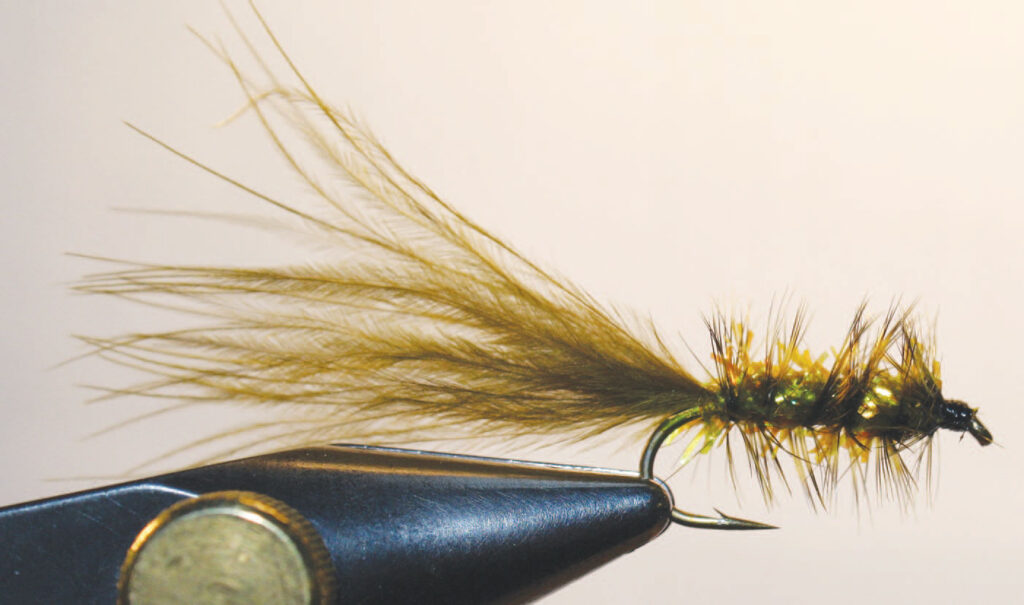
Finding Fish
Eagle Lake trout can grow to huge sizes because they have access to a diverse and plentiful food supply: Tui chubs, leeches, and freshwater shrimp are the main prey items. Caddisflies, damselflies, dragonflies, snails, and mayflies make up the rest of menu. However, while the food is usually everywhere, the trout often aren’t. The key to finding trout is water temperature, as is the case when fishing most still waters. During spring, autumn, and winter, you can expect trout to be feeding in relatively shallow water. However, as the lake’s temperature rises into the high 60s, the trout will move elsewhere (usually to the southern section of the lake) and seek cooler water. In the heat of summer, July and August, when the fish are holding at depths of, say, 50 feet, reaching them with fly gear is almost impossible.
For fly fishers on foot or using float tubes, trout will move into the shallow shoals to feed during the morning and the evening, and may stay there throughout the day if food is present and the water cool enough.
A boat provides the surest way to find fish. Search the points and coves for riseforms. Binoculars can be very helpful.
Fishing Eagle Lake
A fast-action 9-to-10-foot rod for a 5-weight or 6-weight line is perfect for fishing Eagle Lake. As with many still waters, long casts can be important, so I typically fish a weight-forward floating line or a camouflage intermediate line. Sink-tips can be useful, as well, if the trout aren’t feeding at the surface, and you can transform your floating line into a sink-tip by adding sinking leaders such as VersiLeaders, or even Skagit MOW sink tips. These tips are useful for making presentations into channels and cuts and around rock piles. Standard leader lengths are 10 to 12 feet, tapered to a 3X tippet.
Flies are straightforward: Woolly Buggers, leeches, scuds, damselfly and dragonfly nymphs, and assorted other nymphs will all produce hits. Some of the most productive flies fished at Eagle Lake have been designed by Jay Fair, including the Wiggle Tail and his trolling flies.
Wading anglers who are fishing the shoals at Eagle Lake should position themselves at an angle, rather than facing straight out to the main body of water. Turning your body slightly to the left or right and casting in that direction allows the fish to see the entire fly and just not the rear of it, giving multiple fish a viewpoint from a greater distance. Anglers in pontoon boats or standard boats should position themselves the same way. Strip the flies slowly — very slowly. Jay Fair prefers hand-overhand retrieves, but other retrieves work, too. Use small, slow strips, an inch or two long, let the fly rest (that is, fall), and repeat. Retrieves should be “snail slow.”
Eagle Lake and the trout it holds are of historic descent. This area needs to be protected, treasured, and above all experienced. If you have never fished Eagle Lake, you need to go, and if you have not fished Eagle Lake recently, you need to go.
If You Go…
To reach Eagle Lake, if you are traveling from the San Francisco Bay Area, take Interstate 80 toward Sacramento to the intersection with Interstate 505. Take Interstate 80 toward Sacramento to the intersection with Interstate 505. Drive north on I-505 and merge onto Interstate 5. Continue north to Red Bluff and take the Highway 36 exit toward Susanville. Turn left on the Eagle Lake Road about five miles west of Susanville.
If you are driving from Sacramento area, there are a couple of ways to get to Eagle Lake. One is head east to Reno on Interstate 80. From Reno, travel north to Susanville on Highway 395. Drive through Susanville toward Chester on Highway 36, and approximately five miles outside Susanville, turn right on Eagle Lake Road. Or drive north on Interstate 5 to Red Bluff, take the Highway 36 exit, and follow it to Susanville. Approximately five miles from Susanville, Eagle Lake Road will be on your left.
If you are traveling from Redding, take Highway 44 east toward Susanville. At the junction of Highway 44 and Highway 36, turn left. Eagle Lake Road will be on the left of Highway 36, about five miles from Susanville.
Eagle Lake has many campgrounds, lodges, and commercial facilities, plus several marinas. Spaulding Marina and Resort is at 686 Spaulding Road; phone (530) 825-3133. Eagle Lake Marina is situated off of County Road A1; phone (530) 8253454, http://www.eaglelakerecreationarea.com.
You can find an excellent digitized map of Eagle Lake online at www.eaglelakefishing.net/eagle-lake-map.php. It shows the locations discussed above, lake features and water depths, plus roads and campgrounds.
Eagle Lake’s fishing season runs from the Saturday preceding Memorial Day through December 31st, with a limit of two fish per day and four in possession. The lake’s tributaries close to fishing on November 15, and the area inside the breakwater at Gallatin Marina and Pine Creek Slough and Pine Creek below Highway 44 is closed to angling year round.
Lance Gray



